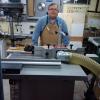I just purchased the subject Nova DVR Drill Press. I measured the run out on the chuck using the usual method and got a pretty nice .0015. But then I grabbed the chuck and pushed and pulled it in the direction of the dial indicator and got more than .010 of lateral movement. So, now I'm not sure whether what I have is good or not. At best, doesn't this indicate the quill bearings are pretty loose? Thanks for any comments.




 Reply With Quote
Reply With Quote




